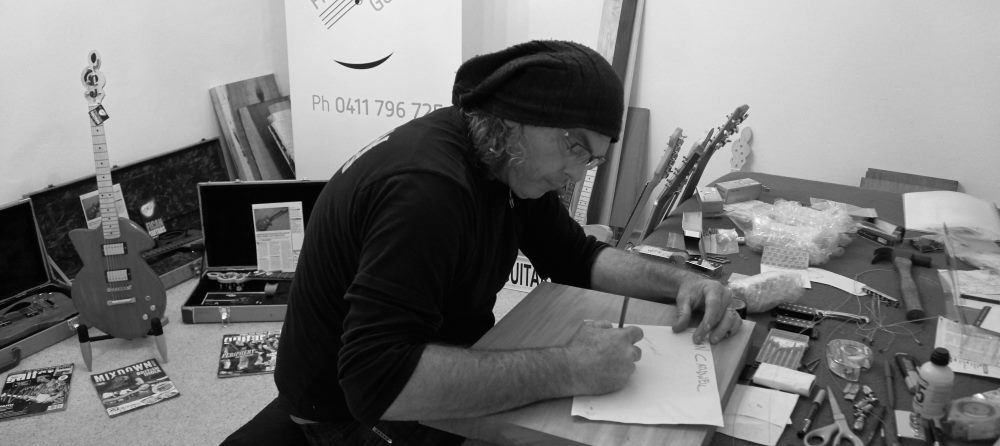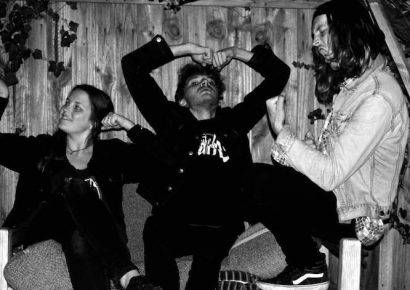You started Fican Guitars about four years ago. What set you off down this path?
I’m a solo acoustic artist – my stage name’s Stuart Jammin – and I injured a fi nger that had to be operated on and it was one of my main playing fi ngers. After having that operation I couldn’t bend my fi nger. I was inspired by reading the story about Brian May making his own guitars and I thought, ‘I could make my own guitar, one with a thicker neck.’
Of course, the thick neck isn’t the only novel design feature of the guitar, is it?
The fi rst guitar I made was an abstract Australia shape and I put a treble clef on the headstock, which obviously nobody’s done before because it’s hard to do with your conventional tuners. So I use banjo tuners on the end – It’s quite a strange looking guitar, different from anything else out there. I got a few orders and that’s where it started. Next thing you know I’ve got four different models up and running.
What else makes your guitars unique?
I’ve created quite a storm because all of the guitars look a bit different. They’re so out there from the traditional guitars that have been around for 100 years. Nothing’s changed really; everybody’s copying the same shapes. A lot of people have said to me, ‘Why didn’t you make it like a Gibson?’ But I think we’re due for change. They’re exciting, they’re unique and they even do a few things that other guitars don’t do.
Tell us about the four guitars in the range. The fi rst guitar you released was the Australian Treble Clef (or the Fican electric).
Yes. To start with we’ve got the Australian Treble Clef. So that has the abstract Australia shape with a treble clef headstock, and that’s an electric guitar.
The second one that you launched was the Fican Tornado…
The Tornado actually has two jacks, so you can put two leads into it. If you want, you can run one to an electric amp, one to an acoustic amp. The top part of the Tornado actually is the acoustic shape and the bottom part of the Tornado is the electric guitar-type shape. And you’ve got the mix of the sounds, so you don’t have to change guitars to do a ballad or do death metal.
Is it essential to run two amps in order to utilise the acoustic and electric sounds?
If you only want to have one amp, you’ve actually got a switching jack on the electric side, so when you pull it out you can still get the electric and the acoustic noises and only run one lead. Somebody said to me, ‘I’m not carrying around two amps.’ Well, you don’t have to. That’s just for the people who want the true sound. But you can still get it relatively similar through one amp.
More recently you introduced the Fican Cardwell to the range. What makes this one different?
I’ve gone this way because a lot of people would prefer to have conventional tuners [instead of banjo tuners] and a conventional headstock. So I did a headstock that is still totally different to everything else. And then you also have a body that looks totally different, but is very comfortable, and I think it’s very pleasing to look at as well. They have Seymour Duncan pickups in them, and I just developed a different sound altogether for electric guitar. It also has coil tapping. It’s a beautiful sounding thing.
Is the Cardwell designed for playing heavier styles of music?
It’s perfect for a lead type application. I’m playing a Tornado when I do gigs. I play as a duo and the other guy sits there and does beautiful lead behind me [on the Cardwell]. The fi nal one is brand new and it’s a bass guitar… It’s called a Fican Gimba. That’s very different again. I talked to lots of bass players about what they desire from a bass guitar and what’s not around. I liked the simplicity of a Fender P bass but a lot of guys didn’t like the huge neck. I use a Jazz neck, so you can use it very fast because it’s very thin.
Where did the names come from?
All my names are made up from the families of trees that the woods come from. For Fican, ‘Fi’ is because I use Fijian mahogany and ‘can’ because I use Canadian maple. The Cardwell is made out of silky oak – it comes from a series of trees called Cardwells. Gimba also is a word developing from different types of wood.
What’s the major motivation for you – to keep expanding your business or to keep experimenting with designs?
I’m a storyteller and it all comes from the heart. If I haven’t got passion involved in it, I’m not doing it.
Fican Guitars will be present at the Melbourne Guitar Show, at Caulfi eld Racecourse August 8 and 9. For more information visit their website.

